Newsletter
Current
Previous
|
December 2010
|
|
|
|

Get to know your Earley
Close Encounters with birds of prey
Pandas in Earley?
Memories of Redhatch Copse
Wednesday Group, Friday Group
Year of the Bat
David Smith's personal memories of Earley
Green Hero, Pavel Fomenko
Life on the Edge
Get involved
Christmas or New Year Presents
Butterflies in France
Transition Town Reading
Earley News and Wildlife Sightings
Maiden Erlegh Reserve in 2010
Forthcoming Events and Bits and Pieces
|
As the International Year of Biodiversity comes to an end, it is only now being realised that biodiversity is of paramount importance. One in five of the world's vertebrates are threatened with extinction, including that magnificent creature, the tiger (see here for the demanding, dangerous job some face to protect it.) A similar plight faces plants and the associated ecosystems that they support. Targets previously set for 2010 have not been met, but at Nagoya, Japan this October agreement was reached on a Strategic Plan for biodiversity with targets for 2020, a protocol on access to and sharing of the benefits of biodiversity, and a resources (finance) mobilisation plan.
We cannot live without food, medicine, air, clothes - things provided by plants and animals. Our personal world may seem small but we live in a global world: witness your food cupboard. Biodiversity may be a global matter, but it is also being tackled nationally and locally. For news on Berkshire's Biodiversity Action Plan check websites
What is Biodiversity? and
Biodiversity Action Plan for Wokingham Borough.
Looking on the bright side, why not spend grey, winter days browsing a website on French butterflies, or there's always Whiskey, the cantankerous Earley Co-op Dairy horse, who can be relied on to make us smile; and remember to check out our future events.
|
|
|
Get to know your Earley: DRAMA AT EARLEY COURT FARM
The Times 26 Nov 1832 (attributed to Reading Mercury)
'On Thursday night at about 11 o'clock as the groom of Mr. William Shackel, of Earley Court Farm, was in the stable he saw a light and on going into the yard he found a barleyrick, standing in a field only separated by a lane from the rick-yard, on fire.' Fire engines from the Protector and County Offices, with whom Mr. Shackel was insured, arrived from Reading as well as the private ones of Mr. Wheble and Mr. Golding. Thatched buildings were protected with waggon cloths which were kept wetted, but the large barleyrick was destroyed. The article continues, 'There can be no doubt that the fire originated with some incendiary, who, by this black deed, was the means of destroying the produce of 23 acres of barley, 6 ½ acres of beans and 24 acres of clover seed.'
(This information was contributed by a descendant of the Shackel family, for which many thanks. Picture courtesy of Reading Museum)
|
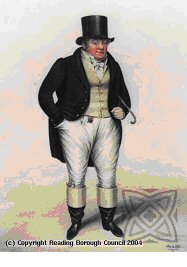
|
The 1830s were a time of desperate poverty for agricultural workers in the Reading area, and of great enclosure of land. In the Capt. Swing riots of the time, Berkshire was one of the worst counties for pauperism. Workers rioted, protesting about their low wages, by burning ricks and destroying machinery. When the riots spread to Berkshire dragoons were dispatched to Reading from Windsor to deal with the rioters and many were arrested. Mr Shackel probably belonged to the local yeomanry, which joined with the dragoons to seek out trouble-makers, so the fire could have been an act of revenge.
(Left, portrait of a well-to-do farmer, William Shackel , 1832, used on a Huntley & Palmer tin)
|
|
|
|
| 
|
Following Ray Reedman's well-received recent articles on the Thrush family , another bird-lover writes of his visit on receipt of a gift voucher to "Feathers and Fur" at Hare Hatch, where one can observe, and in most cases handle, a varied selection of birds of prey. The birds here are captive-bred but are allowed the freedom of the skies for lengthy periods each day in order to keep fit and hone their flying skills. They can certainly spot and take food from some distance, but probably do not have the cutting-edge skills so necessary for survival in the cut-throat wild environment. For this reason they are kept in a secure aviary when not actually flying.
Alan writes: 'To the majority of us, a distant speck circling or hovering in the sky or a split-second blur of a sparrow hawk or hobby swooping to take its prey are about as close as we get to these magnificent animals, and we have to be content with the superb wildlife pictures that now appear frequently on television or in wildlife magazines. In order to partially overcome this situation I therefore paid a visit to "Feathers and Fur" at Hare Hatch where one can observe, and in most cases handle a varied selection of birds of prey. The birds here are captive-bred but are allowed the freedom of the skies for lengthy periods each day in order to keep fit and hone their flying skills. They can certainly spot and take food from some distance but probably do not have the cutting-edge skills so necessary for survival in the cut-throat wild environment. For this reason they are kept in a secure aviary when not actually flying.
On arrival I was greeted by Sadie who clearly has encyclopaedic knowledge of birds of prey and the ways and history of falconry. First on my list of avian introductions was a European Eagle Owl, a huge and magnificent bird who greeted me with a loud and apparently reproachful squawk, as if I hadn't paid her the respect she considered she deserved! Having put on specially-designed leather gauntlets we took her into a nearby field where she took off, flew round a couple of times and then settled on a tree stump some 40 yards away. I was then given a piece of meat to hold and at the given signal she was off - straight as an arrow towards me, landing on my glove and enjoying the food on offer. I was surprised at how light she was for such a huge bird - about 5lbs. Eagle Owls, I was told, hunt primarily by sight which explains why the eyes are so large compared to the heart-shaped facial disc which apparently is an organ of hearing.
| As the bird approaches it is obvious from its staring and unblinking eyes that it is completely focused on just one thing - its prey. I certainly wouldn't give the unfortunate mouse or vole much chance!
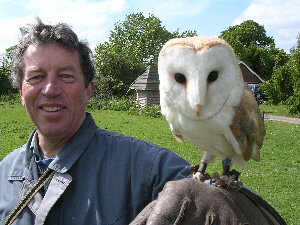
Next on the list was a beautiful Barn Owl. In contrast to the previous species they detect prey mainly by sound and hence the eyes are relatively small although still very sharp! As before, she perched on a convenient branch some distance away; I then happened to look away for a few seconds and was then taken by surprise to find her sitting right beside me, completely unaware of her approach! The ability to fly in near-silence is of course a great aid to hunting mice and voles which the Barn Owl has developed to perfection. This is achieved largely through the structure and layout of the feathers but also by the absence of any oils in the feathers. There is a down side to this; it means that they are not waterproof and are therefore vulnerable to bad weather. Apparently the species has been badly hit this winter, especially in Scotland where it is feared it may again become extinct as an inland breeding species after several years of recovery.'
Alan also had close encounters with and was able to handle a kestrel, a buzzard and a peregrine falcon. To find out more about visits to "Feathers and Fur", which is behind Ladd's Garden Centre at Hare Hatch, go to their website or phone 07812171709. Sessions last 2 hours and need to be booked up in advance. The full article with photos of Alan's visit can be found here.
Disclaimer by Alan:' I have no connection whatsoever with "Feathers and Fur" apart from that of being a satisfied customer.'
|
| Surely climate change hasn't meant the migration of pandas to Earley!
Unfortunately, no. You may wonder what the picture of a panda up a tree is to do with Earley. The tree is obviously not in Earley, but in China, and the pic was taken by EEG members Paul and Linda on their lifetime trip round the world. They've visited many countries and are resting at the moment in Thailand (Oct 30).
Take the trip of a lifetime with them and log on to their journal
|
 |
|
BIG CHANGES IN EARLEY: REDEVELOPMENT OF SIBLY HALL
Many Earley residents may wonder what Sibly Hall is. According to Reading University's website, it is a hostel with 306 single study bedrooms for students, all self-catering. The UoR wish to demolish it to make way for a development of 99 houses; in addition they want to erect a 90ft mast in the adjoining ancient Redhatch Copse. See Application No. SO/2010/2358 on the Wokinhgham Borough Council website |
Memories of Redhatch Copse
"Redhatch Copse is a surviving fragment of ancient woodland on the southern edge of Old Earley. It is a marvellous area of mixed trees and shrubs, and is particularly delightful in spring and early summer before the full canopy of leaves has developed overhead. The ground is then carpeted with shining yellow celandines, paler yellow primroses and the nodding white heads of wood anemones. These are interspersed with a variety of mauve or blue flowers, ground ivy, violets and germander speedwell, among them, and in places drifts of bluebells fill the scene. At one end of the wood, where the ground is more waterlogged, marsh marigolds, or kingcups, display their splendid yellow blooms, with the delicate golden saxifrage still surviving in little patches nearby. These little flowers were much more numerous forty-five years ago, when I first knew Redhatch Copse."
Presciently, Brian adds "It is vital that the health and survival of this and other ancient woodlands in Earley should be ensured for future generations."
Written by Brian Kemp, this is an excerpt from the excellent book Earley Memories: A Century of change, by the Earley Local History Group, pub. 2004. This book and Sutton Seeds are available from Earley Town Council offices, reduced price of £10 each till Christmas. What fantastic Christmas presents!
|
|
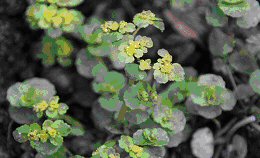 In a 1981 survey the presence of opposite leaved golden saxifrage was noted, and a recent ecological report prepared for the University of Reading in 2005 states that a total of 27 Ancient Woodland Indicator Species have been recorded from Redhatch Copse. Twenty were noted in the 2005 survey and another seven in the 1981 survey. It also notes that within Berkshire, woodlands with this number of indicator species are considered to be of county value, as denoted by its Wildlife Heritage Site designation. In 1981 common dormice were also recorded but are, regretfully, no longer present. In a 1981 survey the presence of opposite leaved golden saxifrage was noted, and a recent ecological report prepared for the University of Reading in 2005 states that a total of 27 Ancient Woodland Indicator Species have been recorded from Redhatch Copse. Twenty were noted in the 2005 survey and another seven in the 1981 survey. It also notes that within Berkshire, woodlands with this number of indicator species are considered to be of county value, as denoted by its Wildlife Heritage Site designation. In 1981 common dormice were also recorded but are, regretfully, no longer present.
The following are some of the reasons for degradation of the Copse which were contained in the recent report: localised soil enrichment by canine waste causing damage to herb-layer and microbial flora, vandalisation of trees by fire, and fly-tipping of garden waste. Most of the problems could be rectified with some tender loving care. Dog walkers could be persuaded to take home dog waste, targeted education might stop vandalisation and fly tipping when locals realise the Copse's value. It is suggested in this report that management of the site could be paid for from income from the 90ft mast, which seems a very heavy price to pay.
Add to this the loss of green space surrounding Sibly Hall, and the pressure from so many new houses, and it's clear to see why there is so much local opposition. There is a campaign being run by Keith Starkey, a local resident. For further information send your details to him at siblyhallag@hotmail.co.uk .
(Date for comments to WBC on the Rushy Mead Wind Farm, F/2010/2266, closed on 30 Nov. We await further developments.)
|
|
|
|
 The Group meets on Wednesday mornings to perform physical tasks in Maiden Erlegh Nature Reserve. Get fit, offer help to Grahame Hawker on 07796170689. The Group meets on Wednesday mornings to perform physical tasks in Maiden Erlegh Nature Reserve. Get fit, offer help to Grahame Hawker on 07796170689.
Recent work: New fences round the lake, removed old fencing round the woodland pond, make and put in barley-straw sausages (Beech Lane end) to prevent the build-up of green algae, weeded butterfly garden, hedge-laying round Marefield Pond with outside help, levelled path in woods, raked the banks and surrounding areas of the new BMX track at Paddick Drive prior to sowing grass seed.
|  Year of the Bat takes flight Year of the Bat takes flight
Launched in Prague this September, the Year of the Bat 2011-2012 will celebrate the world's only flying mammals and promote conservation, research and education.
Following on the informative EEG talk by Claire Andrews this September, she will be leading a Bat Walk on May 25th, 2011 in Maiden Erlegh Reserve, so be sure not to miss it.
|
 The Friday group aim to map the local area for possible walks and cycle rides, search the verges for areas worthy of conservation, and continue looking for veteran trees. The Friday group aim to map the local area for possible walks and cycle rides, search the verges for areas worthy of conservation, and continue looking for veteran trees.
Contact Grahame, see above, with offers of help.
|
|
PERSONAL RECOLLECTIONS BY EARLEY RESIDENT DAVID SMITH (final part)
|
|
MEMORIES OF MOVING TO EARLEY TO ESCAPE THE WAR IN LONDON: David as a young child moved to Earley to stay with relatives at 17 Salcombe Drive after the first bombs dropped on London. Before starting his National Service, David finds a job at the Co-op Dairy, Maiden Erlegh, situated near Luckmore Drive. He was assigned a cantankerous horse, Whiskey. This is the final hair-raising adventure with Whiskey.
|
|
I knew my days as a milkman were coming to an end but there was one more adventure waiting. It was a Friday in November, and Whiskey and I were returning in the dark to the stables. We had to turn right from the Wokingham Road into Maiden Erlegh Drive. There was a car coming and I halted in the middle of the road and let the reins go slack. Whiskey moved across in front of the car. I pulled on the reins so hard that his feet came off the ground. It felt as though the car passed underneath us. He jumped across the road and the sudden movement caused the cart to come forward out of time with him and hit his hind quarters. He leaped forward again and the cart hit him again. He panicked and bolted down the drive. This wasn't a gallop. This was a hurtling, unstoppable charge. I pulled the reins back, shouting for all that I was worth, but his head stayed down.
|
The drive passed through a field and there were horses galloping alongside us. There was a sharp right turn at the end of the drive but Whiskey was not slackening his pace. We were faced with a high holly hedge. At the last moment he swerved to the right, the cart went sideways into the holly and bounced out facing in the right direction. We trotted into the yard as though nothing had happened, without a bottle broken. I was shaking with fear.
"Groom, that horse just bolted".
"Whiskey wudna bolt."
Just then a courting couple appeared with our rear light. "This just fell off the cart that was bolting down the drive."
"Hey, Dave! Did you let that horse bolt?!"
Exciting times for Maiden Erlegh Drive! Thanks to David for these entertaining tales of his youthful days in Earley.
|
|
GREEN HEROES: Pavel Fomenko, protector of tigers
 Unsung hero Unsung hero
Not someone you would have heard of, but a hero nevertheless, although he would probably deny this. Pavel, a native Siberian, works for the WWF, leading an anti-poaching patrol, protecting the Amur (Siberian) tiger in the vast, hostile forest of the Russian taiga. In a single year he helped to catch over 2000 poachers. The WWF approached him in 1994 to lead a fight against illegal hunting of tigers (and the elk, boar and other game that tigers feed on) in the Primorye region in Russia's Far East.
Nights in the forest
Pavel sometimes stays in the forest overnight, when temperatures can drop to -40o; his dog helps to keep him warm, sleeping on his chest.
The spoils
After the collapse of the Soviet Union, Chinese traders flowed through the porous border. A tiger skin, in great demand by the Chinese, can fetch as much as £32,000. It's not hard to see the attraction of poaching by local people where, through poverty, the great need is to survive. There may only be 350 Amur tigers left. The patrols come across hundreds of wooden huts used by the poachers. It can be a dangerous job. In a period of six years, the patrols have seized about 700 guns, 25 tiger skins and countless traps.

Image by: Hollingsworth, John and Karen/USFWS
|
Bad Medicine
Although traditional medicine using tiger parts is now illegal in China, it is still much in demand; all parts of the tiger are used, even a tiger's whisker, supposedly for relieving toothache by pushing it a small way into the bad tooth.
Results
Pavel and his patrols have been able to prevent many tigers being killed, and the WWF are to be commended for providing the financial means to employ these men to protect the Amur tiger. It may be helpful that one well-known tiger supporter is Vladimir Putin.
Watch tiger videos on http://www.wwf.org.uk/how_you_can_help/donate_now/save_the_tiger/watch_tiger_videos/
|
|
|

|
|
Some of the most insignificant plants have an interesting history. Doing a local survey in September with a very knowledgeable EEG member, she noticed a small, sprawling plant growing at an Earley kerbside, and immediately identified it as Galinsoga parviflora. Being an inveterate Googler, a search revealed that this
|
plant had quite a story to tell. It is, in turn, a hated noxious weed in some parts of the world, but cherished as an ingredient in one of Columbia's most famous dishes, Ajiaco Bogotá, Chicken and Potato Soup (recipes on web). One man's tasty plant is another man's poison!
|
|
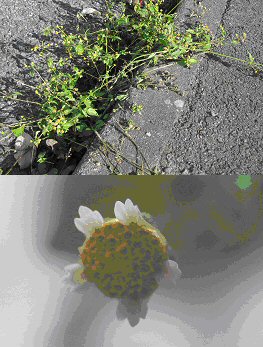 Its cheerful common name is 'Gallant Soldiers' or 'Soldiers of the Queen'. Like soldiers the world over, it increases the local population, producing between 2000 and 10000 seeds, but it has a very poor marching record - about 1.6 km over 10 years. My friend informed me it was first imprisoned in Kew in 1796, and escaped in 1860. For a while it was known as 'Kew Weed'. Since then it has spread gradually as a weed in England (probably in the pots of cultivated plants from nurseries), mainly in towns in the South East. Its botanical name has far more grand origins. It is from Don Mariano Ignacio Martinez de Galinsoga, Spanish botanist of the 18th century, director of the botanic gardens in Madrid, founder of the Madrid Academy of Medicine, and physician to the Queen of Spain. Its cheerful common name is 'Gallant Soldiers' or 'Soldiers of the Queen'. Like soldiers the world over, it increases the local population, producing between 2000 and 10000 seeds, but it has a very poor marching record - about 1.6 km over 10 years. My friend informed me it was first imprisoned in Kew in 1796, and escaped in 1860. For a while it was known as 'Kew Weed'. Since then it has spread gradually as a weed in England (probably in the pots of cultivated plants from nurseries), mainly in towns in the South East. Its botanical name has far more grand origins. It is from Don Mariano Ignacio Martinez de Galinsoga, Spanish botanist of the 18th century, director of the botanic gardens in Madrid, founder of the Madrid Academy of Medicine, and physician to the Queen of Spain.
Geoffrey Grigson, in his splendid book, 'The Englishman's Flora' (pub.1958) wrote that it can be found far in towards Piccadilly, thin, long-legged, with little-flowered daisies, ray plants white, disc flowers yellow - annual, weedy, naturalised little cockneys in a waste corner or uncultivated garden. By 1863 it was established between Kew and East Sheen and Richmond. It liked the asparagus grounds, which supplied the London markets, and then began its march towards the West End.
Richard Mabey in his new book, 'Weeds', recounts that in Malawi, where it is naturalised, it is known as 'Mwamuna aligone' - 'my husband is sleeping'! It is a member of the Daisy family, with 15-20 disc florets and usually 5 ray florets (see photo). Who'd've thought one mean-looking plant could provide so much information. Anyone else noticed this invasion?
|
|
Get involved:
Like mammals? The inaugural meeting of the Berkshire Mammal Group on Thursday 9th December will be held at the Philip Lyle Tower, University of Reading at 7.30pm.
Hate litter? Join EASI (Earley (Earley Adopt-a-Street Initiative). It now has 70 members. If you would like to help, ring Brian on 0118 986 1115. It's not an onerous job, just your local street. A blight on our footpaths and old lanes is small-scale fly-tipping, sometimes carried out over the garden fence. This is illegal and an offence. Green waste collection or disposal at the local tip is the preferred option.
Do you feed the birds in your garden? Join bird feeding research by the University of Reading. www.reading.ac.uk/gardenwatch or write to Melanie Orros, Room 205 Lyle Building, School of Biological Sciences, University of Reading RG6 6BX.
|
Christmas or New Year Presents - stumped for ideas?:
WEEDS by Richard Mabey (Profile Books), a cultural history of weeds. A fascinating read.
Nature Tales, Encounters with Britain's Wildlifes (Elliott & Thompson) a collection of encounters with the natural world. Includes beautifully drawn illustrations and a foreword from Sir David Attenborough.
Map of a Nation: A biography of the Ordnance Survey (Granta). A must for anyone who loves maps.
For children:
WWF Help Save Wild Tigers: cuddly toy including two information booklets. www.wwf.org.uk
Buy a quarter acre of rainforest for £25 through the World Land Trust, and dedicate it to someone as a gift. They will receive a gift pack and certificate. They say, "These are real acres in real places". www.worldlandtrust.org
What about a 'Give and Let Live Ethical Pond Gift'? For every £1 you give they can unlock a further £10 towards creating more ponds. www.pondconservation.org.uk. Certificate and card provided.
|

How about watching
papillons de jour en France?
|
|
France has four times as many butterflies as Britain. Well, they would, wouldn't they! 250 species compared to fewer than 60 here. They have the benefit of so much more land and far less intensive farming than us. That's enough envy of the French, we love them really, and at least we can easily hop over the Channel. Michael McCarthy (The Independent, 20th August) wrote that where he stayed in Normandy in nearby woods and fields there were red squirrels, roe deer, green woodpeckers, hares and even a beech marten which ran through the garden. The grass verges burgeoned with wildflowers. If you decide to go, you should know that the small tortoiseshell is la petite tortue (the little tortoise), the red admiral is le Vulcain (the Vulcan), the gatekeeper is l'Amaryllis, named after a shepherdess in Virgil and La Belle Dame is the painted lady. On a garden visit, he thrilled to the appearance of a scarce swallowtail (iphiclides podalirius), celebrated by the French as le flambé, or the flaming one; its common English name indicates its rarity as a migrant in the UK. It was first described by Linnaeus in 1758. Our swallowtail (papilio machaon, see below) is confined to a small area in the Fens.
|
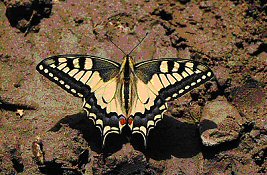 Swallowtail papilio machaon, male, Isere, July 09 |
Scarce swallowtail (La flambé) iphiclides podalirius, Female, Var June 09 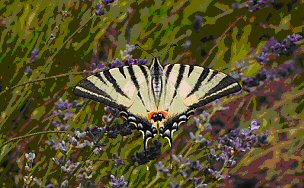 |
|
Photographs by kind permission of Roger Gibbons
Spend a pleasant afternoon browsing his website www.butterfliesoffrance.com. This and its links open up a whole new world. He recommends appropriate guide books. There is a connection with butterflies in Earley. Alexander Stephen Corbet, (1896-1948), was an expert on Malaysian butterflies, and lived for a time in Elm Road. He is buried in St. Peter's churchyard. Along with HM Pendlebury, he wrote the definitive work, An Account of the Butterflies of the Malay Peninsula.
|
|
|
TRANSITION TOWN READING Transition Town groups are sprouting up like mushrooms all over the UK and indeed the world. Reading saw its own first initiatives last August, with a viewing of the film In Transition 1.0, followed by some interactive mapping. The event was very well received and led to the creation of an internet group to facilitate communication, as well as subsequent meetings at two levels: one with people from all over Reading and environs, the other on a more local scale. The town has been divided into four areas, one for each of the cardinal points, forming Transition Neighbourhoods, whose aims are to encourage the local community and economy in making their own transition towards localities active in a world ever less dependent on fossil fuels.
Transition is a grassroots movement encouraging everyone to take action, in the belief that there is time to prepare for the peaking and decline of oil extraction, climate change and economic instability.
In the thinking behind Transition much stress is placed upon naturally producing our own food as close as possible to where we live, on reducing private transport and the consumption of energy. Most of all, in addition to making proper use of land and resources, Transition is about building up a resilient local community based on mutually respectful interdependent relationships. Ornella Trevisan
www.transitionnetwork.org/support/publications/transition-movie
www.transitionreading.org.uk
www.transitionreading.org.uk/2010/11/02/earley-allotment-action-group-in-the-news/>
|
|
|
NEWS FROM BEYOND EARLEY
Last chance for the tiger: Two tiger summits are being held in Russia in November: the Youth summit is being held at Vladivostok, home of the Amur tiger (see here), and the International Tiger summit will be held Nov 21-24 at St.Petersburg, hosted by Vladimir Putin. Heads of government and high-level ministers from 13 countries will meet to finalise details of the Global Tiger Recovery Program, which aims to double the number of tigers in the wild by 2022. Let's hope that something positive will come out of these tiger summits. To lose the tiger would be unthinkable.
Dr. Alan Rabinowitz, expert on tigers (seen recently in Lost Land of the Tiger), will not attend as he thinks this is a fiasco, and nothing practical will come out of it. He feels that unless something drastic is done about poaching, things will not improve; unfortunately, while some staff at tigers' reserves are diligent, others are complicit with the poaching and get off lightly. Time is running out for Dr.Rabinowitz as well as tigers, as he is suffering from leukaemia.
DIRTY OILIn the June Issue 20 , Anne Booth outlined the pollution to the environment caused by the extraction of oil from the vast tar sands in Alberta. This is having a grave effect on the once vast herds of woodland caribou at the most 275 remain. It is also affecting the lives of the Beaver Lake Cree Nation, who depend on the caribou and other wildlife to sustain their way of life. They are mounting a legal challenge to the tar sands operations.
www.co-operativecampaigns.co.uk/toxicfuels
|
EARLEY NEWS and WILDLIFE SIGHTINGS
Kingfishers in Earley Two sightings of kingfishers in September, the first by Marie Anne: I saw a kingfisher in the woods by Maiden Lake on 17/9/10. It was sitting on a perch over the stream about 50m from the end of the woods, near the footpath to the doctors. First time I have seen one in the woods in 10 years! Brian also wrote: I think we saw it last Sunday as well - that's the second time in nearly 40 years. This sighting is quite interesting and useful - one of the arguments against back-garden developments along Silverdale Rd is that the stream there provides a green route from the Loddon up to the lake, for wildlife. I suspect this is what is happening here.
Look out for Waxwings They have been in Bracknell since the beginning of November. These attractive birds can be seen from October to March, having made the journey from Scandinavia. Favourite food - berries, especially rowan and hawthorn, but also cotoneaster and rose, hence their appearance sometimes at supermarket car parks and city centres.
|
|
Maiden Erlegh Nature Reserve in 2010 |
|
It has been a good year for wildlife on and around the lake at Maiden Erlegh Nature Reserve this year, from the flocks of redwings and fieldfares last winter, and opportunities brought about by the heavy snow. Then, foxes in the wood and rats by the waterside could be seen slinking and scampering respectively, silhouetted against the white backdrop. Footprints in the snow betrayed the presence of bird and beast alike, with telltale tracks out across the lake to the ice-bound islands. And the snow caused a surprising amount of damage to the branches of trees, cracking explosively under the unexpected weight.
It seemed like a long, cold winter, and spring came late: the bloom of many wildflowers was delayed a week or two and the blossom on trees and bushes was short, but intense. After chasing away two rival pairs, the Egyptian geese produced their young, though three of the five died along the way, and the Canada geese suffered mixed fortunes. The first family of four survived intact, a combined nursery of a further ten was steadily depleted, whereas the fourth family was wiped out in its entirety - a diminutive, fluffy, but headless carcass on the footpath marked its final passing. Better news with the swans, however, which having shared their island with the brooding geese, eventually produced four (though now only three) young of their own in June. As for the ducks, it is almost impossible to keep count, but there were mallard ducklings aplenty. (Moreover, for one day only, there was a visiting pair of tufted ducks at Easter). Gallinules too have been more plentiful this year, with two pairs of coots, three young 'cootlings' and up to six moorhens at a time. Other juveniles included the heron, which has taken to stalking
about on the larger island, balancing up and down on the branches projecting out at water level. Similarly placed was a young cormorant in May, adding to the number of regulars on the lake which rose from two to three this year.
|
Not on the lake, but in the adjacent trees, the woodpeckers have been vocal, though not as visible as last year. However, a hole in one of the trees overlooking the perimeter path provided the nest for one pair, and the cheeping red-crested head of a woodpecker chick could be seen peeping out at the end of May. A single tern arrived in May while the June skies saw the circling of summer swifts, and on one occasion, as many as nine red kites.
Frogs, stag beetles, mice and a hedgehog could all be found on the lakeside path in May and June. The foxes so evident in March and May, were also prominent in late evenings of July, with groups of up to four, and individuals seen openly trotting along Lakeside, past the weir and playground out on to the sports field. On occasions, at dusk, others would pause in the foliage just six or seven feet from the path, regardless of the human presence.
As the days shortened in September, bats could be seen at dusk, over the lake against the setting sun: up to a dozen pipistrelles in the air above and daubentons skimming the water. September also brought visiting birds of passage. The Canada geese swelled to 37 at one count and for the first time since 2005, a pair of grebes could be seen diving on the lake.The wild flowers may have bloomed behind their usual schedule, but many lingered late. In a year that was marked by unusually profuse cowslips, hemlock waterdropwort, thistles, great willowherb and chicory, the bellflowers and fleabane continued throughout September. New to me in 2010 were the dainty cutleaf cranesbill, kidney vetch, meadow vetchling and the delightful common field speedwell, along with the rare sight of the snakeshead fritillary in flower for a mere two days.
|
As I write, snow is forecast - further north it's true - but the year is about to turn full circle. Edwin A.R.Trout
|
|
LOCAL FORTHCOMING EVENTS 2011
|
January: | Monday 10th January 7.30 start AGM of the Earley Environment Group, followed by a presentation on Veteran Trees and the Veteran Trees of Earley by Elaine Butler and Sheila Crowson. Come and learn about the why, where and how of the Wokingham District Veteran Tree Survey, with special reference to trees in Earley. Function Room, Maiden Place Community Centre, off Kilnsea Drive.
Check out the trees now surveyed by the Wokingham District Veteran Tree Assn. on www.wdvta.org.uk/WDVTS.
| |
February | Wednesday 9th February 7.30 start SUSTRANS working in the Thames Valley: Increasing levels of walking, cycling and public transport use benefit our economic prosperity in so many ways, as well as people's health, the environment and our communities. An overview of the work of SUSTRANS by Peter Challis with examples of local projects. Function Room, Maiden Place Community Centre, off Kilnsea Drive.
| |
March: | Sunday 27th March Litter Clean-up: 2 sessions: 10 a.m. to 12.30 p.m. and 2 to 4.30 p.m. Register participation with ETC on (0118) 9868995.
| |
April: | Wednesday 6th April 7.30 start Amber, Mysterious Time Capsule, a talk by Kit Brownlee looking at amber: What is it? Where is it found? When is amber not amber ? Come along and find out some of the answers. Function Room, Maiden Place Community Centre, off Kilnsea Drive.
|
|
And don't forget our Christmas social, 7.30 Dec 13 at the Interpretation Centre, Instow Road. Live music and refreshments.
|
Future events - further details in the March newsletter
|
4th May | Ray Reedman will help us with Warbler Identification. The sights and sounds that will aid us on our Dawn Chorus walk on the 8th.
|
|
8th May | Dawn Chorus Walk - Lavell's Lake/Dinton Pastures. 6.30- 8.30 a.m. Meet in Lavell's Lake Car Park.
|
|
|
Bits and pieces
LOVE FOOD HATE WASTE especially at Christmas-time. Want to know how to order the right amount of food, how to make use of the left-overs, make the most of your freezer? Then attend a free True Food workshop being run by Emma Barnett from the government's Love Food Hate Waste campaign on Dec 8th 5-6pm or 6-7pm, Wesley Methodist Church Hall, Queens Road, Reading. Phone 0845 330 or email Helen@truefood.coop . Check details on www.lovefoodhatewaste.com.
A bit of time to spare? Can you offer active help to the Group? If you can, phone 0118 962 0004 or go to the website. We would welcome more member involvement. If you have no expertise and would like to get involved, you may be able to give practical help. Perhaps help with distributing the newsletter hard copies, or maybe you have graphic design skills (for occasional posters, leaflets), computer skills, any other skills to offer. Do your bit for the environment.
Join the EEG Yahoo Group and post your sightings and messages. You’ll find a link to Yahoo on our website.
EEG Committee Members can be found on www.earleyenvironmentalgroup.co.uk under Contacts, or phone 0118 962 0004
For Wildlife Survey Forms, go to the website or phone Earley Town Council 0118 986 8995
Comments or contributions to the newsletter to: sheila.crowson@ntlworld.com or 2 Reeds Avenue, Earley, RG6 5SR. We would welcome short contributions from members to the newsletter.
If you know anyone who would like to join EEG, membership forms are available from Earley Town Council, 0118 986 8995, on the website under Downloads , or send an e-mail to liz@helva.plus.com . Please inform Liz if you intend to change e-mail or address at 50 Kenton Rd, Earley RG6 7LG, or send her an e-mail.
|
SUPPORT YOUR LOCAL SHOPS
The True Food Co-op, Silverdale Centre :There is now a True Food Co-op operating in Earley, their most successful market. Their mission is to take low cost organic food out to the people, bypassing the supermarkets which charge a lot for organics They hold markets at the Silverdale Centre on Fridays, 5 to 8. 15 pm. They have a website giving dates www.truefood.coop
Pet Fayre 9 Maiden Lane Centre Lower Earley : A small independent shop, with bird feeders of all kinds, a variety of bird feed, large bags of which the shop is willing to deliver locally, or pick it up in your car from the back of the shop, tel 0118 9266512, e-mail sales@petfayre-reading.co.uk or go on the comprehensive website www.petfayre-reading.co.uk
|
|
Our thanks to ORACLE Corporation for reproducing our newsletter on recycled paper. Oracle is the world's second largest software company, situated at Thames Valley Business Park in Earley. Oracle UK adheres to the ISO14001 Environment Standard which confirms Oracle has considered and acted upon its environmental impact. As part of Oracle’s corporate social responsibility they support a number of local groups, including us. They have given us valuable support in reproducing the hard copies of our newsletter in colour, as well as printing off posters and membership leaflets for us to distribute to libraries, schools etc. |
|